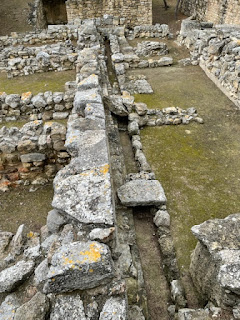The Island of Crete, Greece March 24, 2022
Crete is the largest and the most populous (650,000)of the Greek Island and the 5th largest in the Mediterranean. It is flanked on the north by the Aegean Sea and the Libyan Sea on the south. It is very mountainous with the highest peak at 8058 feet, Mount Ida, of the White Mountain Range. It has 650 miles of coastline ranging from lovely sandy beaches to rocky and cliffy terrain. It also boasts to have more than 30 million olive tress, and yes it seemed every square inch of the island was covered in Olive groves. Olive oil production is a major economic driver along with tourism. Heraklion is the capital with about 144K population. Normally Crete has a semitropical and moderate climate. However while we were there they experience the coldest winter in 30 years. The mountains were still covered in snow and snow had fallen at the higher elevations a few days ago and the day we were there.
Crete was populated from 2700 to 1420 BC by the advanced civilization of the Minoans, which were then overrun by the Mycenaeans (from mainland Greece), then the Romans, Byzantine Empire, Andalusian Arabs, Venetian Republic and Ottomans from which they gained independence in 1898. Crete became part of Greece in 1913.
Crete has a strong association with the Ancient Greek gods and the Minoan Civilizations. It is believed that god Zeus was born in the Dirtaen Cave at Mount Dikti. The Palace for Knossos a Bronze Age Settlement and ancient Minoan city is located in Heraklion. The labyrinth of the Palace of Knossos was the setting for the myth of Theseus and the Minotaur in which the Minotaur ( half bull half man, son of Minos’s wife Pasiphae) was slain by Theseus.
The Palace consisted of 1300 rooms all interconnected and spread over 3 acres with the separate outbuildings covering 5 acres. The Palace had four wings that centered around a central courtyard. It was rather advanced for its time as it had a water and sewer system. Yes, they even had toilets, more on the line of outhouses, but they had a flushing system and they were indoors. The Palace of Knossos was destroyed by a combination of earthquakes and the invading Mycenaeans c.1450. Only the Palace itself was spared. The remains were found in 1878.
For more details you’ll just have to Google it.
Our port of call was to have been Heraklion but due to high winds the captain opted to dock at the city of Chania in the deep bay, Souda Bay. It’s waters might have been calmer, but the winds and temperatures where brutal. When we thought we could not get any colder we surely did while visiting the Palace of Knossos. I think the windchill was around 40. We had a 2 1/2 hour bus ride through the picturesque countryside and shoreline of Crete before arriving at Heraklion and the Palace of Knossos. During our ride our very informative guide told us the many mythological stories that are so much part of the Greek heritage and character. They are very proud of their heritage and children from an early age are told of all the Creek Mythology. Once we got there, there were several other Viking tour groups and it felt like another ‘Viking Invasion’, though not as bad as at the city of Olympia. (When we docked at Katakolon, the sister ship Viking Sky was also there and of course had tour groups going to the same places. Since we were essentially the only tourists there, as it was totally off-season, everyone exploring the city of Olympia were Viking passengers mostly clad in the blue Viking jackets that had been given to everyone.) It was fascinating to see the grounds and remains, many of which have been restored.
Sir Arthur Evens began excavation and restoration process of the site in 1899. Though, he has been highly criticized for the use of concrete in his restoration process. Concrete of course was not used or known in those days and it now falling apart and his restorations are now having to be restored. Non-the-less all very impressive. What was disappointing was that one of the most famous frescoes, the famed Dolphin frescoes in the Queen’s quarter, was not to be viewed. The real one is at the Heraklion Museum. For that matter all the real frescoes that had been painstakingly put back together, like a picture puzzle, are in the Museum and only replicas are at their original site.
After a bone chilling tour of the Palace of Knossos we were treated to a delightful Greek 4 course luncheon with wine of course. The wine helped to warm us up and most napped on the bus-ride back to Souda Bay.
View of the island of Crete
On one side we saw the lovely and peaceful looking country-side and on the other side the turbulent ocean.
We arrive at the Palace of Knossos and are greeted by the statue of Sir Arthur Evans, who began the excavation and restoration of the Palace.
View of the water canals that serviced all the buildings.
View of restored sections of the settlement
Entry way to the Palace
Inside one of the many rooms and a frescoes replica. Original ones were found in pieces and were re-assembled and can be viewed at the Heraklion Museum. Regrettably time did not permit a visit to the Museum.
Now these are original storage vessels that too were found in pieces and re-assembles. The lighter sections are fabricated inserts as the original pieces were not found,
The inside of the king’s chambers
The entry way of the Queen’s chambers that we could not enter, also the location of the famed dolphin frescoes.
Another replica of a frescoes.
Frescoes of a Bull
The open-air theater
One of the original roads leading in and out of the Palace complex


























Comments
Post a Comment